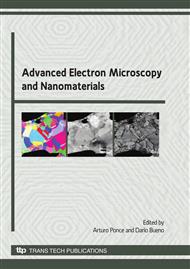p.1
p.9
p.13
p.17
p.21
p.25
p.29
Synthesis of Plasticizer-Based Ferrofluid and its Use in the Preparation of Magnetic PVC Nanocomposite
Abstract:
A magnetic polyvinylchloride (PVC) nanocomposite was prepared by static casting using a plasticizer-based ferrofluid. Two sets of nanocomposites were prepared: one under the influence of magnetic field and the other without magnetic field. The effects of ferrofluid content and the magnetic field on the magnetic and mechanical properties of the nanocomposite were studied in detail. Magnetite (Fe3O4) nanoparticles used for the ferrofluid preparation were prepared by the chemical co-precipitation method. Dioctyl phtalate (DOP)-based ferrofluid was prepared by the peptization technique. X-ray diffraction (XRD) was used to characterize the superparamagnetic behavior of the nanocomposite. A Universal tensometer was used to evaluate their mechanical properties. The results showed that the magnetization value of the nanocomposites increased as a function of ferrofluid concentration with all the samples showing superparamagnetic behavior. The mechanical studies showed that the tensile strength and elongation at break of the magnetic PVC nanocomposite were increased by the addition of ferrofluid and the applied magnetic field.
Info:
Periodical:
Pages:
13-16
Citation:
Online since:
March 2010
Keywords:
Price:
Сopyright:
© 2010 Trans Tech Publications Ltd. All Rights Reserved
Share:
Citation:


